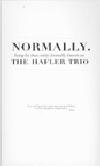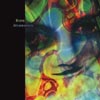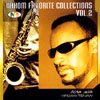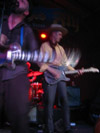Soleilmoon
The voice of Blixa Bargeld of Einsturzende Neubauten is the rawmaterial from which Andrew McKenzie constructed the sounds on the twodiscs comprising
Normally.Disc one begins with silence. Silence is merely sound that lingers justbeyond the threshold of audibility. Silence is unpotentiated space.Sound is the dissipation and usurpation of silence. When sound beginsto gradually seep into the silence of
Normally, the experience is akin to the onset of a hallucination. For
Normally,McKenzie is not interested in language; any whispers or screamscontributed by Mr. Bargeld are rendered indecipherable, and henceforthaffect the listener on a purely subconscious, subliminal level. This istellingly similar to the practice of talismanic magic, where theconscious desire is sublimated through a series of transformations intoirretrievably esoteric codes and diagrams, bizarre correspondences andperverted anagrams. Magic and ritual are McKenzie's primary motivationson
Normally. Like the hallucinatory state, where the mind issometimes freed to make sympathetic connections between thought andmanifestation, so too the sounds on
Normally contribute to anunraveled head-state in which synchronicities are the rule rather thanthe exception. At various times during my first listen to disc one, aslayers upon layers of meditational aumgns are gradually compounded, Iheard the unmistakable sounds of descending piano scales, mewlingkittens, distant muffled screams, even the sound of my front doorviolently being forced open. These were phantasms, no doubt, catalyzedby the abstract drones and ghostly monasterial choirs that McKenziesculpts. By the 28-minute mark, the piece has taken on the majesticintensity of Gyorgi Ligeti's haunting choral works, sounding like theinfinite vibratory intonations cascading from the void of space. Disctwo, or "Sphotavado," deals primarily with the breath. Just as AleisterCrowley noted after a lifetime of study devoted to the tantricmeditation, there is no better purgative than pranayama (breathcontrol), and no better way to enervate the aspirant than therepetition of mantra. Using Bargeld's mantric recitations and breathyintonations, McKenzie provides a series of distinct, dynamic passagesover the 65-minutes of the disc. Each passage fades in and out likebreathing, and each takes the listener to a more remote, rarefiedstrata of magical conception. From the gentle, reedy abstractions ofthe opening passage all the way to the serpentine, metallic Kundalinibrain-swipes of the final breath. At high volumes, many of theseprocessed sounds vibrate portions of the ear canal in an unexpectedway. I found that by moving my head back and forth, or changing myposition in the room, I could radically change the experience oflistening to "Sphotavado." McKenzie, therefore, has created a raresound sculpture which can be actively engaged and changed by thelistener. The enigmatic packaging and accompanying foldout bookletcreate a remarkable series of "blinds" that distract and mislead evenas they lay bare the central theme of
Normally; words createvibrations; vibration is the result of sound; sound is the articulationof existence; existence is created by a single word, vibrated.
samples:
 Exotica has never quite grown beyond its initial renaissance ofinterest in the early 90's. Even among its most avid fans andcollectors, it's still considered something of a novelty: mildlydiverting, but ultimately disposable musical kitsch. Recent attempts atresurrecting exotica by John Zorn and Tipsy have been a little tooreverent for their own good - studied facsimiles of 1950's exotica byMartin Denny or Les Baxter - largely academic with zero soul orsincerity.
Exotica has never quite grown beyond its initial renaissance ofinterest in the early 90's. Even among its most avid fans andcollectors, it's still considered something of a novelty: mildlydiverting, but ultimately disposable musical kitsch. Recent attempts atresurrecting exotica by John Zorn and Tipsy have been a little tooreverent for their own good - studied facsimiles of 1950's exotica byMartin Denny or Les Baxter - largely academic with zero soul orsincerity.


 Sam Beam, the man behind Iron & Wine, has changed his approach onthis, his second full-length album. The previous album featured Beam onhis own, playing the instruments (primarily guitar and banjo) andrecording at home on a 4-track. Our Endless Numbered Daysfinds him employing the help of the musicians who accompany him in liveperformances, playing a wider variety of instruments, and recording ina studio. Although this allows Beam to broaden his horizons musically,it seems that in the process his new material suffers from being lesspersonal and more watered-down. Though Beam tends to wear his gentlyfolky influences on his sleeve (i.e. Nick Drake and Tim Buckley), hesucceeds in making the style into something which is unique. "On YourWings," which kicks the album off to a promising start, soon peters outinto the wimpy "Naked As We Came," which is musically along the linesof I&W's first records, but overpowered by maudlin lyrics.Unfortunately, Our Endless Numbered Days is hard pressed torecover the initial spark with which it began. That is not to say thatthe album is wholly without merit. "Teeth in the Grass" has an earthycharm, and "Each Coming Night" is beautiful, albeit brief return toform. Sadly, however, these are the exception and not the rule.
Sam Beam, the man behind Iron & Wine, has changed his approach onthis, his second full-length album. The previous album featured Beam onhis own, playing the instruments (primarily guitar and banjo) andrecording at home on a 4-track. Our Endless Numbered Daysfinds him employing the help of the musicians who accompany him in liveperformances, playing a wider variety of instruments, and recording ina studio. Although this allows Beam to broaden his horizons musically,it seems that in the process his new material suffers from being lesspersonal and more watered-down. Though Beam tends to wear his gentlyfolky influences on his sleeve (i.e. Nick Drake and Tim Buckley), hesucceeds in making the style into something which is unique. "On YourWings," which kicks the album off to a promising start, soon peters outinto the wimpy "Naked As We Came," which is musically along the linesof I&W's first records, but overpowered by maudlin lyrics.Unfortunately, Our Endless Numbered Days is hard pressed torecover the initial spark with which it began. That is not to say thatthe album is wholly without merit. "Teeth in the Grass" has an earthycharm, and "Each Coming Night" is beautiful, albeit brief return toform. Sadly, however, these are the exception and not the rule.  This 1990 live recording documents an interesting moment in the history of one of the U.S.?s most interesting and long-standing avant-garde collectives. Under the early tutelage of Chris Cutler, the Colorado-based group has, since 1979, produced a wealth of music rooted in the early admirer/member's progressive legacy, an elusive, genre-bending approach with a particular emphasis on rustic folk-pop and dark, frayed psychedelia.
This 1990 live recording documents an interesting moment in the history of one of the U.S.?s most interesting and long-standing avant-garde collectives. Under the early tutelage of Chris Cutler, the Colorado-based group has, since 1979, produced a wealth of music rooted in the early admirer/member's progressive legacy, an elusive, genre-bending approach with a particular emphasis on rustic folk-pop and dark, frayed psychedelia. Though the policies of containment kept the political and geographicalboundaries of free thought and fascist oppression clearly defined inthe early 1980's, the strength of the iron curtain was not enough toprevent ideas from crossing into and beyond the bloc. Begnagrad iscomprised of members who were all exposed to the burgeoning punk andprogressive rock music scenes in their hometown of Ljubljana, Slovenia,then part of communist Yugoslavia. The band is the product of fivedaring multi-instrumentalists who combined Alpine and Eastern Europeanfolk concepts with modern rock, free-jazz influences and a distinctsense of whimsy. Their self-titled album, originally released in 1982,is a fascinating example of the creative minds and wonderful ideas thatflourished in less pleasant times and circumstances. The tracks theyproduced are impressively intricate, with numerous instruments spinningoff around each other in a complex weave of sound and rhythm. "Pjan ska/ Drinking One" begins with a swirling arrangement, accordions andwoodwinds etching out those alpine peaks as they rise and fall beforelaunching into a full steam ahead horn sprint, as if James Chance werefronting a Bohemian (geographically, that is) dance ensemble. Finallyspliced with the enthusiastic mock yodeling of the band members, "Pjanska" spends itself in an amusing gasp of grinning energy. "Bo Ze (CeBo) / All's Good (Maybe)" is a relentlessly charming track, whoseloping, oscillating bass rhythm inspires the urge to make jaunty,whirling circles, arms linked with another in the midst of coy, flirtydance. What makes Begnagradsuch an engaging, satisfying listen is the pure joy that emanates fromthe music, a sense of deeply passionate humanism that can often be lostin experimental, fusion, and avant-garde music. This feeling isexemplified in two live bonus tracks that document the band on aEuropean tour. "Tazadnatanova / Thelastnewone" is an intense,rollicking piece that is driven by a furious punk rock energy, squallswith saxophone riffage and sputters about on jagged, post-punk guitars,but ultimately is fully entrenched in the warmth and togetherness ofthe band's folk-troubadour roots. The band launches into a frantic jig,pushing themselves and their audience to clap along and dance withmanic energy. The crowd can be heard clapping, whistling, hooting, andpouring themselves heart and soul into the song. Potentially thehappiest record I have heard in a very long while, Beganagradmanages to be progressive by utilizing the past, finding the originalmotivator for musical expression: to entertain, to bring peopletogether, and make them feel as if they are involved in somethingbeautiful.
Though the policies of containment kept the political and geographicalboundaries of free thought and fascist oppression clearly defined inthe early 1980's, the strength of the iron curtain was not enough toprevent ideas from crossing into and beyond the bloc. Begnagrad iscomprised of members who were all exposed to the burgeoning punk andprogressive rock music scenes in their hometown of Ljubljana, Slovenia,then part of communist Yugoslavia. The band is the product of fivedaring multi-instrumentalists who combined Alpine and Eastern Europeanfolk concepts with modern rock, free-jazz influences and a distinctsense of whimsy. Their self-titled album, originally released in 1982,is a fascinating example of the creative minds and wonderful ideas thatflourished in less pleasant times and circumstances. The tracks theyproduced are impressively intricate, with numerous instruments spinningoff around each other in a complex weave of sound and rhythm. "Pjan ska/ Drinking One" begins with a swirling arrangement, accordions andwoodwinds etching out those alpine peaks as they rise and fall beforelaunching into a full steam ahead horn sprint, as if James Chance werefronting a Bohemian (geographically, that is) dance ensemble. Finallyspliced with the enthusiastic mock yodeling of the band members, "Pjanska" spends itself in an amusing gasp of grinning energy. "Bo Ze (CeBo) / All's Good (Maybe)" is a relentlessly charming track, whoseloping, oscillating bass rhythm inspires the urge to make jaunty,whirling circles, arms linked with another in the midst of coy, flirtydance. What makes Begnagradsuch an engaging, satisfying listen is the pure joy that emanates fromthe music, a sense of deeply passionate humanism that can often be lostin experimental, fusion, and avant-garde music. This feeling isexemplified in two live bonus tracks that document the band on aEuropean tour. "Tazadnatanova / Thelastnewone" is an intense,rollicking piece that is driven by a furious punk rock energy, squallswith saxophone riffage and sputters about on jagged, post-punk guitars,but ultimately is fully entrenched in the warmth and togetherness ofthe band's folk-troubadour roots. The band launches into a frantic jig,pushing themselves and their audience to clap along and dance withmanic energy. The crowd can be heard clapping, whistling, hooting, andpouring themselves heart and soul into the song. Potentially thehappiest record I have heard in a very long while, Beganagradmanages to be progressive by utilizing the past, finding the originalmotivator for musical expression: to entertain, to bring peopletogether, and make them feel as if they are involved in somethingbeautiful.  Underground hip-hop allstars cLOUDDEAD either win people over in excess or lose them completely, and their sophomore full-length isn't likely to change that much. There is no compromise in this music: there is only with or against this interesting lot.
Underground hip-hop allstars cLOUDDEAD either win people over in excess or lose them completely, and their sophomore full-length isn't likely to change that much. There is no compromise in this music: there is only with or against this interesting lot. Don't ever feel afraid to strike up a conversation with afriend/associate who's not from your country about food of theircountry, a reward might be in the future. I was talking to an Ethiopianperson I knew about Ethiopian food and she told me that I must try aplace that's sort of off the beaten path, somewhat hidden and in an oddlocation in Boston, a place I had been relatively familiar with buthave never realized a good restaurant existed there. I had been to acouple other Ethiopian places in Boston, one I thought was dreadful butone I was quite fond of, however, when you get a recommendation from anEthiopian (or an Indian about Indian food, or Japanese, Mexican,etc,...), you take them up on it. So I took Jessica out for herbirthday and the food that night was fantastic. The place was full withplenty of Ethiopian patrons all talking with the staff like they werefamily, which is always a good sign. The music being played wasexcellent and by the time this one song came on, I had to get up andfind out what it was. The slap-bass and looped drum patterns weren'tmuch unlike old stuff from 23 Skidoo and I was completely in a trance.I went to the bar and the bartender wrote it down in a language Icouldn't read and told me to take the sheet of paper to the South EndFood Emporium and hand them the sheet of paper. The following day I didand ended up with this CD. It's not completely unexpected from a foodmart: the sound quality is pretty shoddy (cassette tape "breathing"sounds can be heard), the packaging looks less than legal, and there'sno web site coming up with the aforementioned URL. However, that songwhich originally stole my heart, "Wey Arada" (listen below) was wellworth the trek and worthy enough to share. The disc is a collection oftunes from this blind singer, he carries a saxophone but it's hard tohear a real sax on the disc, as a number of the songs are poorlyproduced with cheap synths. The vocal style is completely un-Western,but not dissimilar to singers of the Middle East while the music isundoubtedly African in nature, with numerous interwoven timesignatures, upbeat guitars, and keyboard instruments playing prettytones. The songs are bright and springy for the most part and it shouldgo without saying that I've got absolutely no clue what's being sung. Acouple standout tracks, like the hypnotic "Tzta," is nearly ten minutesof sheer beauty which oddly enough has to get faded out (I wonder howlong the band actually went on playing the repeated bars).Unfortunately without the web site for the label working, I've got noinformation to share about the musician nor any idea how to get itelsewhere, so, for those who find it as captivating I did, a quest inyour own city might be in order.
Don't ever feel afraid to strike up a conversation with afriend/associate who's not from your country about food of theircountry, a reward might be in the future. I was talking to an Ethiopianperson I knew about Ethiopian food and she told me that I must try aplace that's sort of off the beaten path, somewhat hidden and in an oddlocation in Boston, a place I had been relatively familiar with buthave never realized a good restaurant existed there. I had been to acouple other Ethiopian places in Boston, one I thought was dreadful butone I was quite fond of, however, when you get a recommendation from anEthiopian (or an Indian about Indian food, or Japanese, Mexican,etc,...), you take them up on it. So I took Jessica out for herbirthday and the food that night was fantastic. The place was full withplenty of Ethiopian patrons all talking with the staff like they werefamily, which is always a good sign. The music being played wasexcellent and by the time this one song came on, I had to get up andfind out what it was. The slap-bass and looped drum patterns weren'tmuch unlike old stuff from 23 Skidoo and I was completely in a trance.I went to the bar and the bartender wrote it down in a language Icouldn't read and told me to take the sheet of paper to the South EndFood Emporium and hand them the sheet of paper. The following day I didand ended up with this CD. It's not completely unexpected from a foodmart: the sound quality is pretty shoddy (cassette tape "breathing"sounds can be heard), the packaging looks less than legal, and there'sno web site coming up with the aforementioned URL. However, that songwhich originally stole my heart, "Wey Arada" (listen below) was wellworth the trek and worthy enough to share. The disc is a collection oftunes from this blind singer, he carries a saxophone but it's hard tohear a real sax on the disc, as a number of the songs are poorlyproduced with cheap synths. The vocal style is completely un-Western,but not dissimilar to singers of the Middle East while the music isundoubtedly African in nature, with numerous interwoven timesignatures, upbeat guitars, and keyboard instruments playing prettytones. The songs are bright and springy for the most part and it shouldgo without saying that I've got absolutely no clue what's being sung. Acouple standout tracks, like the hypnotic "Tzta," is nearly ten minutesof sheer beauty which oddly enough has to get faded out (I wonder howlong the band actually went on playing the repeated bars).Unfortunately without the web site for the label working, I've got noinformation to share about the musician nor any idea how to get itelsewhere, so, for those who find it as captivating I did, a quest inyour own city might be in order.  The voice of Blixa Bargeld of Einsturzende Neubauten is the rawmaterial from which Andrew McKenzie constructed the sounds on the twodiscs comprising Normally.Disc one begins with silence. Silence is merely sound that lingers justbeyond the threshold of audibility. Silence is unpotentiated space.Sound is the dissipation and usurpation of silence. When sound beginsto gradually seep into the silence of Normally, the experience is akin to the onset of a hallucination. For Normally,McKenzie is not interested in language; any whispers or screamscontributed by Mr. Bargeld are rendered indecipherable, and henceforthaffect the listener on a purely subconscious, subliminal level. This istellingly similar to the practice of talismanic magic, where theconscious desire is sublimated through a series of transformations intoirretrievably esoteric codes and diagrams, bizarre correspondences andperverted anagrams. Magic and ritual are McKenzie's primary motivationson Normally. Like the hallucinatory state, where the mind issometimes freed to make sympathetic connections between thought andmanifestation, so too the sounds on Normally contribute to anunraveled head-state in which synchronicities are the rule rather thanthe exception. At various times during my first listen to disc one, aslayers upon layers of meditational aumgns are gradually compounded, Iheard the unmistakable sounds of descending piano scales, mewlingkittens, distant muffled screams, even the sound of my front doorviolently being forced open. These were phantasms, no doubt, catalyzedby the abstract drones and ghostly monasterial choirs that McKenziesculpts. By the 28-minute mark, the piece has taken on the majesticintensity of Gyorgi Ligeti's haunting choral works, sounding like theinfinite vibratory intonations cascading from the void of space. Disctwo, or "Sphotavado," deals primarily with the breath. Just as AleisterCrowley noted after a lifetime of study devoted to the tantricmeditation, there is no better purgative than pranayama (breathcontrol), and no better way to enervate the aspirant than therepetition of mantra. Using Bargeld's mantric recitations and breathyintonations, McKenzie provides a series of distinct, dynamic passagesover the 65-minutes of the disc. Each passage fades in and out likebreathing, and each takes the listener to a more remote, rarefiedstrata of magical conception. From the gentle, reedy abstractions ofthe opening passage all the way to the serpentine, metallic Kundalinibrain-swipes of the final breath. At high volumes, many of theseprocessed sounds vibrate portions of the ear canal in an unexpectedway. I found that by moving my head back and forth, or changing myposition in the room, I could radically change the experience oflistening to "Sphotavado." McKenzie, therefore, has created a raresound sculpture which can be actively engaged and changed by thelistener. The enigmatic packaging and accompanying foldout bookletcreate a remarkable series of "blinds" that distract and mislead evenas they lay bare the central theme of Normally; words createvibrations; vibration is the result of sound; sound is the articulationof existence; existence is created by a single word, vibrated.
The voice of Blixa Bargeld of Einsturzende Neubauten is the rawmaterial from which Andrew McKenzie constructed the sounds on the twodiscs comprising Normally.Disc one begins with silence. Silence is merely sound that lingers justbeyond the threshold of audibility. Silence is unpotentiated space.Sound is the dissipation and usurpation of silence. When sound beginsto gradually seep into the silence of Normally, the experience is akin to the onset of a hallucination. For Normally,McKenzie is not interested in language; any whispers or screamscontributed by Mr. Bargeld are rendered indecipherable, and henceforthaffect the listener on a purely subconscious, subliminal level. This istellingly similar to the practice of talismanic magic, where theconscious desire is sublimated through a series of transformations intoirretrievably esoteric codes and diagrams, bizarre correspondences andperverted anagrams. Magic and ritual are McKenzie's primary motivationson Normally. Like the hallucinatory state, where the mind issometimes freed to make sympathetic connections between thought andmanifestation, so too the sounds on Normally contribute to anunraveled head-state in which synchronicities are the rule rather thanthe exception. At various times during my first listen to disc one, aslayers upon layers of meditational aumgns are gradually compounded, Iheard the unmistakable sounds of descending piano scales, mewlingkittens, distant muffled screams, even the sound of my front doorviolently being forced open. These were phantasms, no doubt, catalyzedby the abstract drones and ghostly monasterial choirs that McKenziesculpts. By the 28-minute mark, the piece has taken on the majesticintensity of Gyorgi Ligeti's haunting choral works, sounding like theinfinite vibratory intonations cascading from the void of space. Disctwo, or "Sphotavado," deals primarily with the breath. Just as AleisterCrowley noted after a lifetime of study devoted to the tantricmeditation, there is no better purgative than pranayama (breathcontrol), and no better way to enervate the aspirant than therepetition of mantra. Using Bargeld's mantric recitations and breathyintonations, McKenzie provides a series of distinct, dynamic passagesover the 65-minutes of the disc. Each passage fades in and out likebreathing, and each takes the listener to a more remote, rarefiedstrata of magical conception. From the gentle, reedy abstractions ofthe opening passage all the way to the serpentine, metallic Kundalinibrain-swipes of the final breath. At high volumes, many of theseprocessed sounds vibrate portions of the ear canal in an unexpectedway. I found that by moving my head back and forth, or changing myposition in the room, I could radically change the experience oflistening to "Sphotavado." McKenzie, therefore, has created a raresound sculpture which can be actively engaged and changed by thelistener. The enigmatic packaging and accompanying foldout bookletcreate a remarkable series of "blinds" that distract and mislead evenas they lay bare the central theme of Normally; words createvibrations; vibration is the result of sound; sound is the articulationof existence; existence is created by a single word, vibrated. When a band displays all the ferocity that could rip my muscles off mybody sinew by sinew it gets my pulse going, and that's exactly whatGuapo have on this, their fifth full-length. Recent work with CerberusShoal and the addition of a third member Daniel O'Sullivan have bothtaken Guapo down a new and risky path where they seem to let their hairdown more, worrying less about the artifice and more about the art.These songs are almost painfully direct with less noodling and inherentdistraction than previous work and the band is all the stronger for it.The one weakness is that Five Sunswears a bit thin in a few areas as a result of almost incessantrepitition — particularly on the title track, represented as one longpiece with five track separations. As a result the album cannot beendured in one sitting, but the pure aggression and brave reaching istantalizing all over. When taken in portions it is a delicious andfulfilling meal. The title track starts the record, and the firstsection features non-structured jamming with quiet keyboards and loudcymbals and gongs. Eventually the quieter moments are broken by louderdrumming and guitar noise, then a full-out sonic assault is unleashed,with distortion and deafening percussion climaxing in a loud squeal. Iwas beside myself as the song moved to its next section, a morestructured collaboration with driving bass and percussion and a playfulkeyboard. The piece itself put me in full-out sway mode, but here theinternal repeating of the same parts grates a bit, then it all seems tostart over but with more squealing. The third section redeems it, alljazz drumming and piano solos with touches of shred guitar. It islengthy, but it never wanes once, with a steady pace and varied tempos.I let the sound embrace me, and the remaining suns made me secure,paranoid, and warm as the tracks progressed, ultimately devouring me ina wall of sound like a tidal wave. A brief intermission, and then"Mictlan" and "Topan," two tracks that share the same aesthetic butbecome far more melodic and structured. These were scenes in ahunter/hunted movie, with a relentless killer and a hapless victim inan elaborate game of cat and mouse. I felt closer to them than "FiveSuns" and all its glory. There is a beauty in their simplicity that Ienjoyed, and that I will reach for again and again even though theywere a bit darker in tone. Overall, however, Guapo has created a soundfor this record drenched in solidarity, and when they keep it simplethey just soar.
When a band displays all the ferocity that could rip my muscles off mybody sinew by sinew it gets my pulse going, and that's exactly whatGuapo have on this, their fifth full-length. Recent work with CerberusShoal and the addition of a third member Daniel O'Sullivan have bothtaken Guapo down a new and risky path where they seem to let their hairdown more, worrying less about the artifice and more about the art.These songs are almost painfully direct with less noodling and inherentdistraction than previous work and the band is all the stronger for it.The one weakness is that Five Sunswears a bit thin in a few areas as a result of almost incessantrepitition — particularly on the title track, represented as one longpiece with five track separations. As a result the album cannot beendured in one sitting, but the pure aggression and brave reaching istantalizing all over. When taken in portions it is a delicious andfulfilling meal. The title track starts the record, and the firstsection features non-structured jamming with quiet keyboards and loudcymbals and gongs. Eventually the quieter moments are broken by louderdrumming and guitar noise, then a full-out sonic assault is unleashed,with distortion and deafening percussion climaxing in a loud squeal. Iwas beside myself as the song moved to its next section, a morestructured collaboration with driving bass and percussion and a playfulkeyboard. The piece itself put me in full-out sway mode, but here theinternal repeating of the same parts grates a bit, then it all seems tostart over but with more squealing. The third section redeems it, alljazz drumming and piano solos with touches of shred guitar. It islengthy, but it never wanes once, with a steady pace and varied tempos.I let the sound embrace me, and the remaining suns made me secure,paranoid, and warm as the tracks progressed, ultimately devouring me ina wall of sound like a tidal wave. A brief intermission, and then"Mictlan" and "Topan," two tracks that share the same aesthetic butbecome far more melodic and structured. These were scenes in ahunter/hunted movie, with a relentless killer and a hapless victim inan elaborate game of cat and mouse. I felt closer to them than "FiveSuns" and all its glory. There is a beauty in their simplicity that Ienjoyed, and that I will reach for again and again even though theywere a bit darker in tone. Overall, however, Guapo has created a soundfor this record drenched in solidarity, and when they keep it simplethey just soar.  If ever there was a band to be filed under "unfinished business" it
would be American Music Club. In late 1994, leader Mark Eitzel pulled
the plug on the band amidst a cloud of mounting debt, commercial
failure and acrimony and set sail on a solo career that rivaled AMC in
its highs and lows. In recent years it seemed Eitzel went wherever the
wind would take him — recording a covers album in Chicago and
re-recording AMC classics in Greece — but now he's back home in San
Francisco with American Music Club. Original members Vudi (guitar), Dan
Pearson (bass) and Tim Mooney (drums) are back and Marc Capelle
(keys/trumpet) has taken the place of Bruce Kaphan (pedal steel). Late
last year they began work on a new album and played sporadic shows in
California, now they're doing select dates across the US and UK,
beginning with these two appearances at Austin's annual clusterfuck,
the South By Southwest festival.
If ever there was a band to be filed under "unfinished business" it
would be American Music Club. In late 1994, leader Mark Eitzel pulled
the plug on the band amidst a cloud of mounting debt, commercial
failure and acrimony and set sail on a solo career that rivaled AMC in
its highs and lows. In recent years it seemed Eitzel went wherever the
wind would take him — recording a covers album in Chicago and
re-recording AMC classics in Greece — but now he's back home in San
Francisco with American Music Club. Original members Vudi (guitar), Dan
Pearson (bass) and Tim Mooney (drums) are back and Marc Capelle
(keys/trumpet) has taken the place of Bruce Kaphan (pedal steel). Late
last year they began work on a new album and played sporadic shows in
California, now they're doing select dates across the US and UK,
beginning with these two appearances at Austin's annual clusterfuck,
the South By Southwest festival. Perhaps "Home" is Eitzel's confession on where he stood before the
reunion when he emotively bellows "I got lost! I started to hate my own
skin!" Eitzel seems considerably reigned in with the band, less
self-deprecating and spontaneously combustible, but still lovably
disagreeable at times. Danny and Mark quibbled over what song to play
next as often as they playfully slam danced. Tim was a tornado on drums
and intently watched Eitzel for cues. Marc head banged and bounced in
his seat while playing keys. And Vudi was as calm and collected and
eccentric as ever sporting big hats, scarves, cowboy boots and what
looked to be a guitar made of metal. After band members and fans alike
convinced Mark back on stage at the final show, he announced "this is
the last time we're ever playing this fucking song" and they launched
into an explosive rendition of "Bad Liquor" that left the South Texas
evening air sizzling.
Perhaps "Home" is Eitzel's confession on where he stood before the
reunion when he emotively bellows "I got lost! I started to hate my own
skin!" Eitzel seems considerably reigned in with the band, less
self-deprecating and spontaneously combustible, but still lovably
disagreeable at times. Danny and Mark quibbled over what song to play
next as often as they playfully slam danced. Tim was a tornado on drums
and intently watched Eitzel for cues. Marc head banged and bounced in
his seat while playing keys. And Vudi was as calm and collected and
eccentric as ever sporting big hats, scarves, cowboy boots and what
looked to be a guitar made of metal. After band members and fans alike
convinced Mark back on stage at the final show, he announced "this is
the last time we're ever playing this fucking song" and they launched
into an explosive rendition of "Bad Liquor" that left the South Texas
evening air sizzling.
